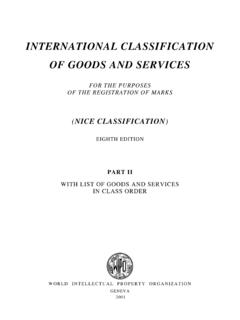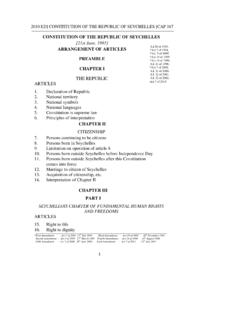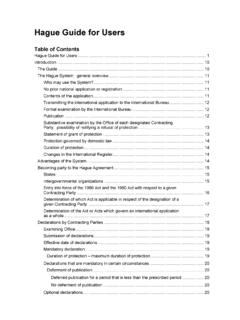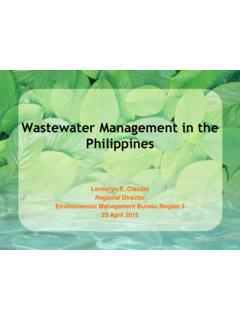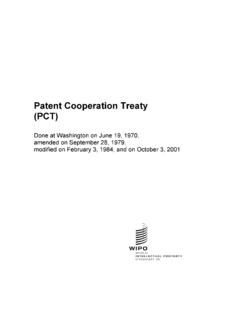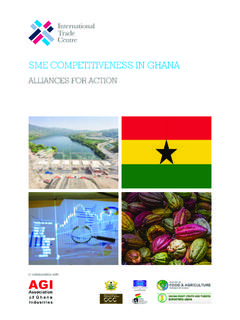Transcription of Geographical Indications - An Introduction - WIPO
1 Geographical IndicationsAn IntroductionDisclaimer: The information contained in this publication is not meant as a substitute for professional legal advice. Its main purpose is limited to providing basic publication provides an Introduction to Geographical Indications (GIs), explaining their basic features, use and protection as an intellectual property right. Written for non-experts, it is a starting point for readers seeking to learn more about the the publication focuses primarily on the protection of GIs as an intellectual property right, it also addresses the economic and social dimensions of GIs and re-sponds to the questions most frequently raised by policymakers.
2 Producers and other stakeholders who wish to begin the process of developing a GI scheme for a publication was prepared by the Design and Geographical Indication Law Section of the World Intellectual Property Organization ( wipo ), composed of Mar a Paola Rizo, Nathalie Frigant and Violeta Ghetu, under the supervision of Marcus H pperger. The authors express their sincere thanks to Daphne Zografos, Traditional Knowledge Division of wipo , Matthijs Geuze, International Appellations of Origin Registry of wipo , and Valentina Jim nez-Burger for their valuable 6 Introduction page 8 Key concepts8 What is a Geographical indication?
3 10 Can Geographical Indications only be used for agricultural products?13 What is the difference between a Geographical indication and a trademark?13 What is the difference between a Geographical indication and an appellation of origin?page 15 Developing a Geographical indication why?15 Geographical Indications as differentiation tools in marketing strategies: from mere source indicators to brands17 Geographical Indications as a factor of rural development18 Geographical Indications as a means to preserve traditional knowledge and traditional cultural expressionspage 21 Developing a Geographical indication what is involved?
4 22 What are the costs?22 How long does it take? page 23 Protecting Geographical Indications a step in developing a Geographical indication23 Why protect a Geographical indication?23 Deterring free-riding24 Forestalling registration of the Geographical indication as a trademark by a third party24 Limiting the risk of the Geographical indication becoming a generic term25 What does a protected Geographical indication enable you to do? What does it not enable you to do?Table of contents28 How to obtain protection for a Geographical indication?
5 28 Sui generis systems of protection31 Collective marks and certification marks32 Laws focusing on business practices 34 How long does it take to protect a Geographical indication through registration?34 What are the potential obstacles to protecting a Geographical indication?34 Conflict with a prior mark34 Generic character34 Homonymous Geographical indications34 The indication is the name of a plant variety or animal breedpage 35 Protecting Geographical Indications abroad35 Why protect your Geographical indication abroad?
6 35 How are Geographical Indications protected abroad?35 Bilateral agreements37 Direct protection37 Lisbon Agreement 39 Madrid systempage 41 Conclusion42 Bibliography and further reading6 IntroductionSince the adoption of the Agreement on Trade-Related Aspects of Intellectual Property Rights (the TRIPS Agreement) in 1994, which contains a section on Geographical Indications (GIs), this form of intellectual property (IP) has attracted increasing attention from policymakers and trade negotiators, as well as pro-ducers (mostly of agricultural products)
7 , lawyers and economists across the world. It is undoubtedly because of the TRIPS Agreement section on GIs that the issue now appeals to more and more na-tions beyond the rather restricted list of countries that have traditionally pursued active GI have traditionally been considered to be IP. Article 1(2) of the Paris Convention for the Protection of Industrial Property of 1883 (Paris Convention) refers to in-dications of source and appellations of origin as objects of industrial property. Paragraph (3) of the same article speci-fies that the term industrial property is not limited to industry and commerce proper, but applies also to agricultural and extractive industries and to all manufac-tured or natural products, such as wines, grain, tobacco leaf, fruit, cattle, minerals, mineral waters, beer, flowers and flour.
8 The inclusion of Indications of source and appellations of origin and the specific ref-erence to a series of agricultural products in early versions of the Paris Convention are clear evidence that the 19th century diplomats who negotiated the international convention, primarily to protect inventions shown at international exhibitions, had not overlooked this, arguably, most ancient form of intellectual asset. Famous ancient brands are sometimes associated with products that have a specific geographi-cal origin and go back as early as the 5th century BC, such as wine from the Greek island of Chios, referred to as an expensive luxury good in classical period following the conclusion of the Paris Convention saw numerous efforts aimed at increasing the level of multila-teral protection afforded to Indications of source and appellations of origin, which led, among others things.
9 To the adoption of the Madrid Agreement for the Repression of False or Deceptive Indications of Source on Goods of 1891, and the Lisbon Agree-ment for the Protection of Appellations of Origin and their International Registration of 1958 (Lisbon Agreement), and to the inclusion, in the TRIPS Agreement, of a special section on is an abundant literature addressing the legal effects, rights and obligations flowing from the various multilateral agree-ments on GIs, as well as an ever-growing number of bilateral agreements containing chapters on GIs.
10 This publication offers an Introduction to GIs for readers new to the subject. It provides an overview of key definitions, basic policy considerations concerning the protection of GIs and an Introduction to salient IP law-related the background of a lengthy, pas-sionate debate on the preferred form of legal protection for GIs, it is important not to lose sight of the value of GIs as intangible assets. Geographical Indications are distinctive signs used to differentiate competing goods. They are collectively owned with a strong inherent origin-base, namely the Geographical origin to which they refer.

